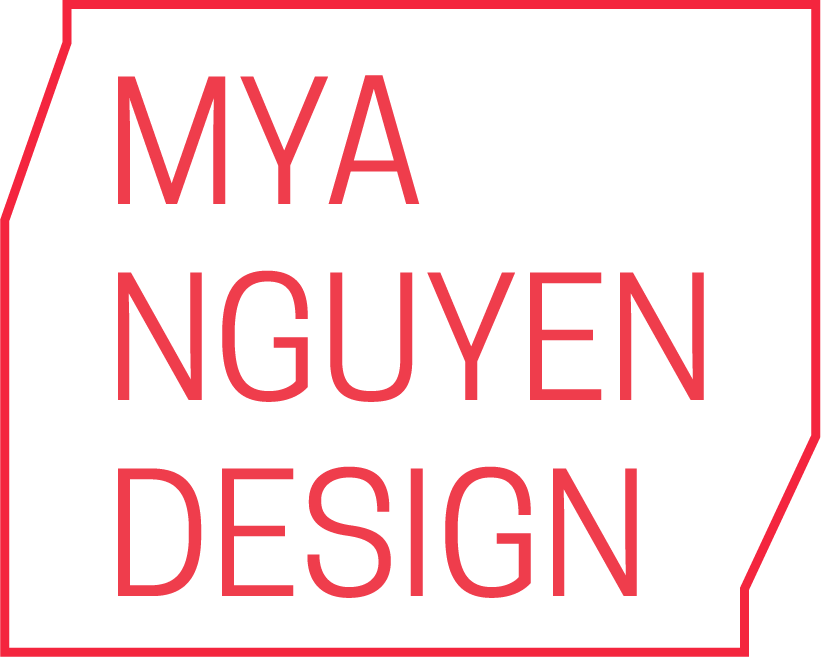DRIP Textiles:
A Project About Sweat
PHYSICAL PRODUCT — Agutter: Senior Studio – 2022
DRIP is a project that aims to reduce the social alienation people with hyperhidrosis (excessive sweating) can feel. Through streetwear aesthetics, DRIP stylizes sweat, portraying people’s differences as unique, as opposed to unnatural.
Having lived with hyperhidrosis (specifically in the hands) my entire life, I utilized my experience as the empathetic motivation for this project. While hyperhidrosis can impede functions of everyday life, the social alienation imposed by the condition outweighs its physical implications. Major impacts expressed by people with hyperhidrosis include limitations in relationships, and impairments in emotional and mental health. The miniscule portion of the American population living with hyperhidrosis further exacerbates the concept of social othering.

EXISTING MITIGATION
When researching treatments for hyperhidrosis, I found that people take extensive and irreversible measures (such as surgery and microwave therapy) of body altercation in order to fit a social standard. This discovery led me seek out current methods people with hyperhidrosis employ to alleviate sweat, without changing their bodies. I interviewed 5 people with sweaty hands, asking them what habits they have developed to dry them. The resounding answer to my investigation was simple- people with hyperhidrosis commonly wipe their hands on clothing to quickly and temporarily rid them of moisture.
PRIMARY MODE OF ABSORPTION


I began observing my use of clothing to absorb sweat throughout the course of a week. When standing, I tended to place my hands around my hips, to mimic a commonplace action and avoid calling attention to myself. The most trafficked area was around the hip line, and waned towards the waist.
SECONDARY MODE OF ABSORPTION


When sitting, the wiping motion focused on the top of the thigh, primarily between the knee and upper thigh. Although less used, the side of the high thigh, and knee area were also utilized to wipe sweat.
TEXTILE RESEARCH
Following the textile-based solution route, I began to analyze issues that common fabrics experience when being used to soak up sweat on a consistent basis. Challenges fabrics used in the most common clothing face include the wear and breakdown of common cotton (1), fading of dyes and dyes coloring hands (2), and low absorption capacity (3). Other textile-based means of sweat mitigation, such as carrying a hand towel (4), may be unattractive or bring unwanted attention to a person’s hyperhidrosis.
1 (COTTON)
![]()

2 (DENIM)
![]()

3 (POOR ABSORBENCY)
![]()

4 (TOWEL)
![]()

FUNCTIONAL PRECEDENTS

Next, I turned to embossing and textural techniques that paper towels and period underwear utilized to achieve quick absorption and maximum capacity. Textual and empirical research revealed that closer, more frequent indents in fabric produce more variance in surface area, making for quicker absorption. Various forums, blogs, and videos from mothers using fabric diapers confirmed that layering a quick absorbing top layer, like microfiber, and a high liquid capacity base layer, like hemp, reduces the amount of moisture left against babies’ skin. These two insights led to the design of the absorbent composite material I planned to use to absorb sweat.

MATERIAL SELECTION
I tested samples of various hydrophilic materials before settling on a terry towel-like fabric for the base, or bottom layer, of the absorbent pad, and a lightweight cotton-spandex blend (80/20) for the top layer. The terry has a very high absorbency capacity, and subsequently takes a while to fully absorb and dry. The cotton blend, conversely, has a quick absorbency and dry time, but cannot hold much. Implementing the layering method from my research into cloth diapers, I utilized the materials to form a high absorbency capacity, quick absorbency and dry time material.
SAMPLES






TOP: COTTON/SPANDEX
BOTTOM: TERRY CLOTH

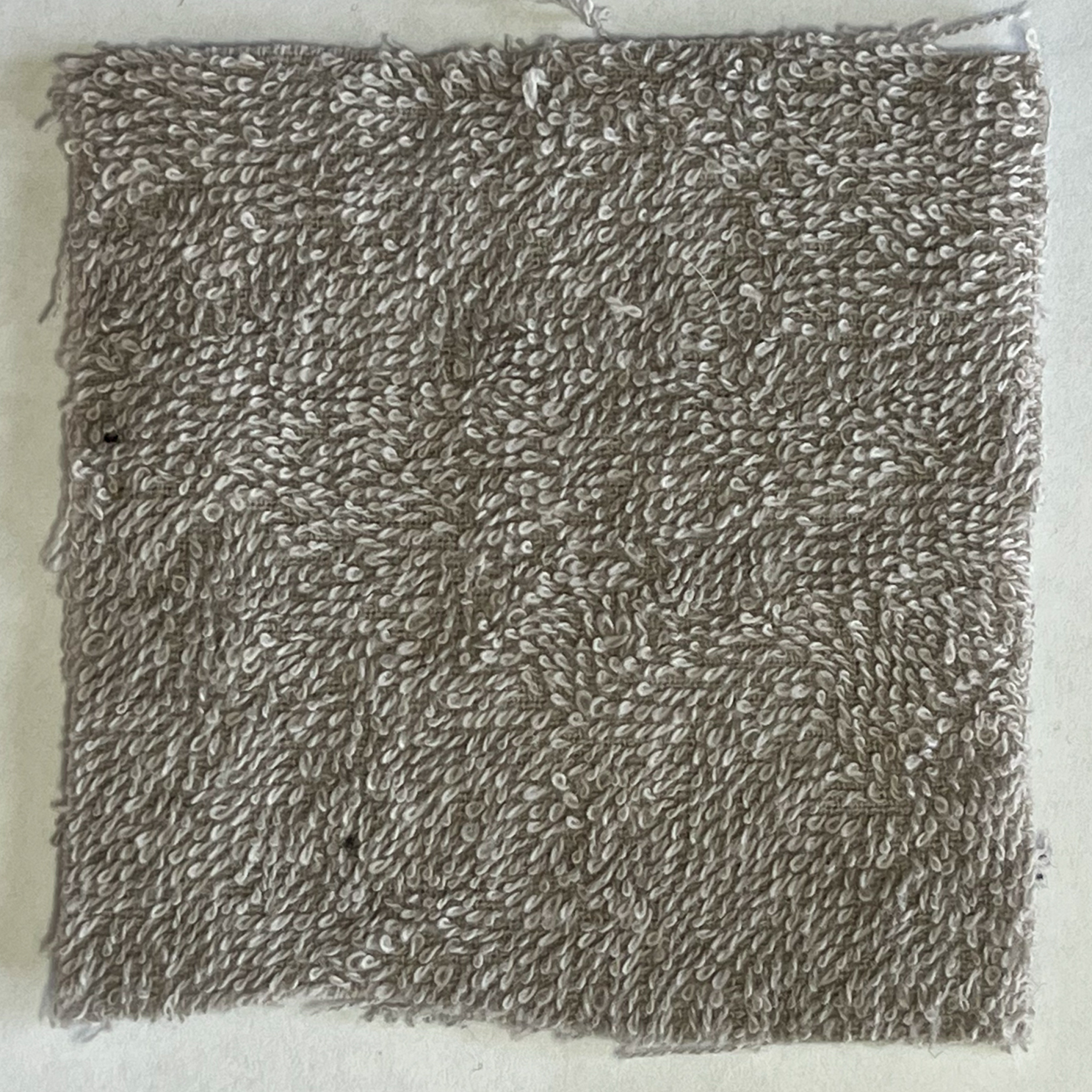
I sewed a grid into the pad to create a sudo-embossed effect and higher surface area variance, allowing the top fabric to more quickly absorb sweat and pass it on to the bottom layer. The sewn grid also pulls the cotton blend taught enough to resist the wear of pulling, but leaves it loose enough to effectively invite moisture through its fibers.


AESTHETICS
After selecting fabrics and having a general idea of a clothing-related design intervention, I collected formal precedents to guide the outward feel of the solution. I wanted the design to have an overall “cool” look and vibe, to give the wearer a positive sense of distinction and individuality, rather than difference and exclusion that accompanies a condition like hyperhidrosis. The appearance of the clothing-based design was inspired by 90’s hiphop and rap streetwear, as well as contemporary urban trends.

SKETCHING
Once the form and function had direction, I began sketching potential product interventions. I prioritized a vest-like form, to address the primary mode of sweat absorption, and additionally, pants to address the secondary mode— with both solutions incorporating the absorbent materials from the prior research.
VEST
PANTS







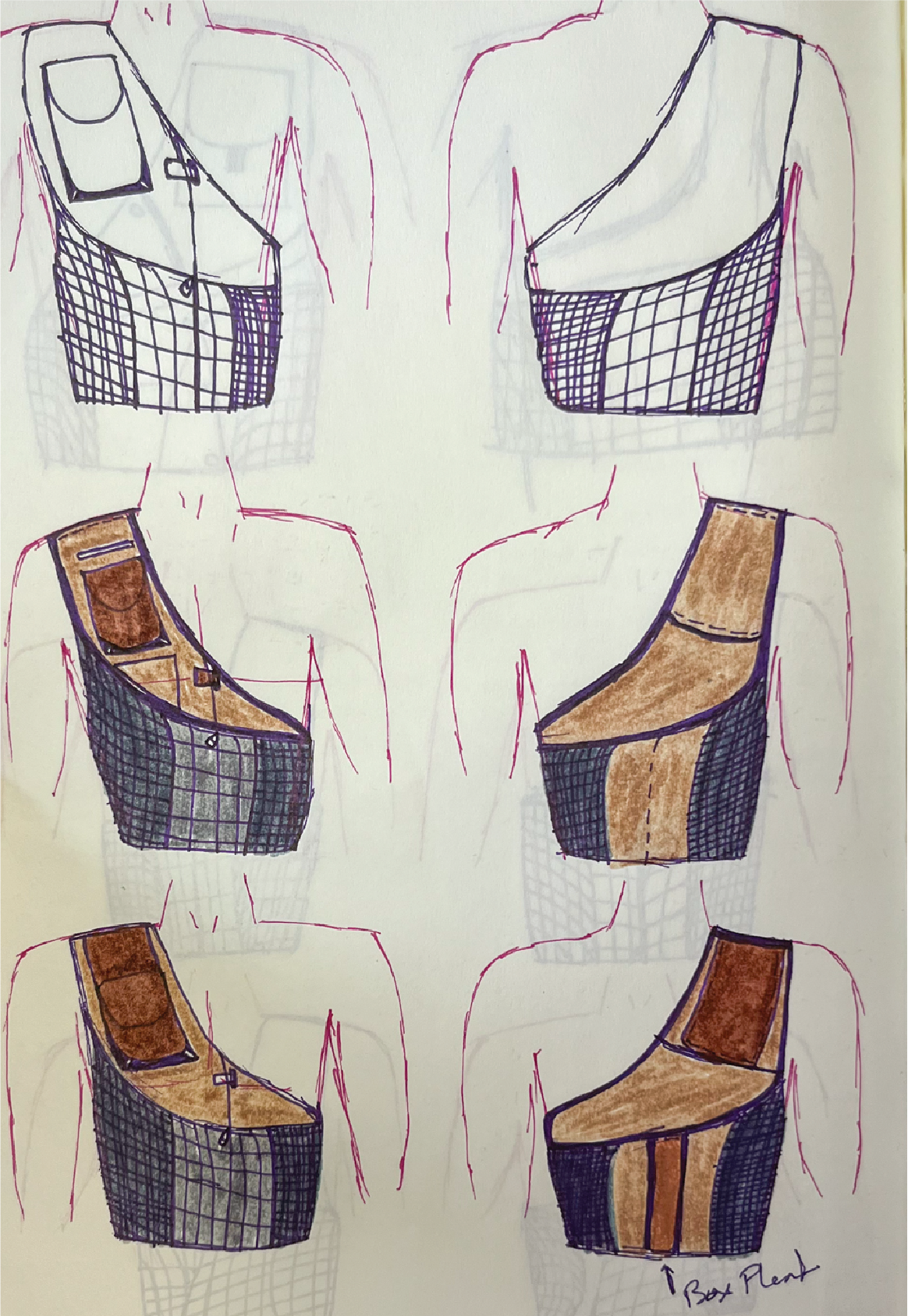

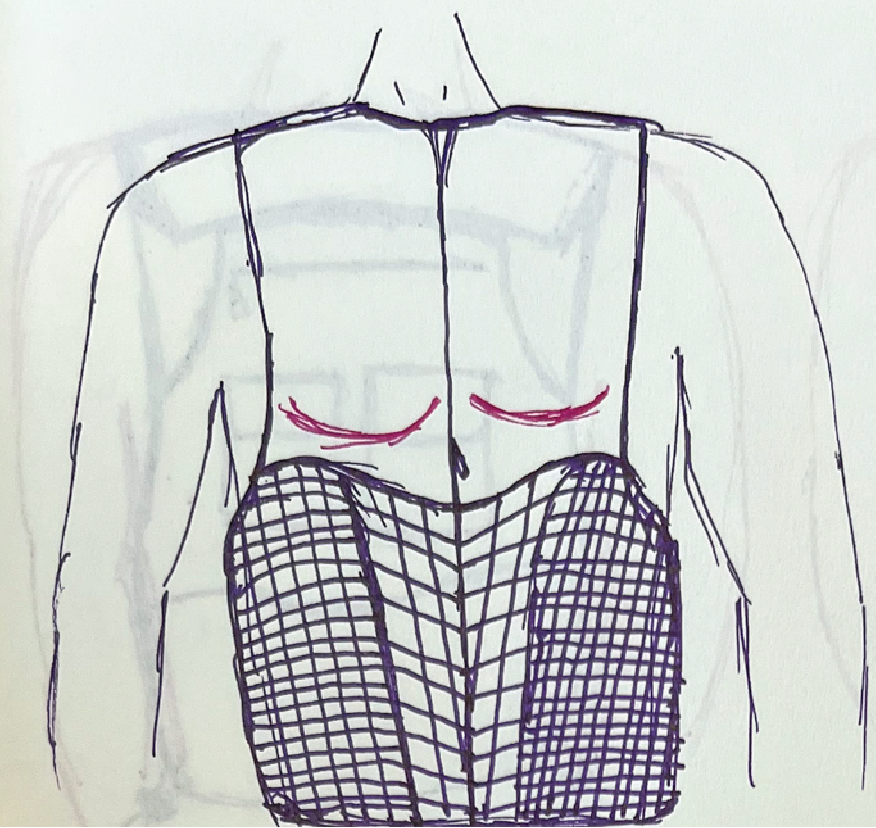



















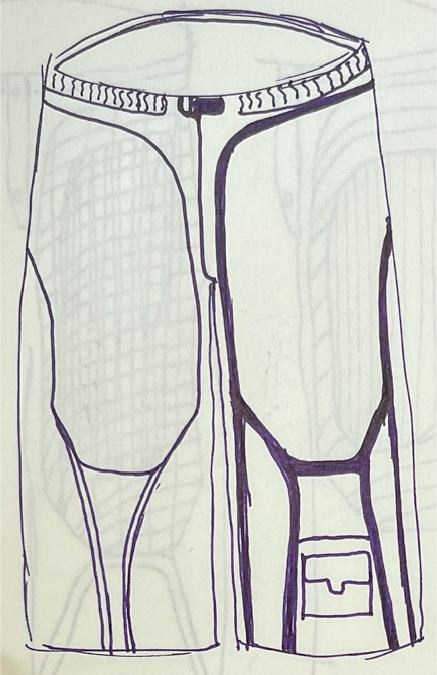

STRUCTURAL MATERIALS
Following rough outlines of product solutions, I selected the final materials that made up the main structural components of both the pieces of clothing. Although hyperhidrosis is typically an independent variable, heat can exacerbate the condition, so I opted for breathable, light materials for the majority of the garment, excluding the absorbent pads. Additionally, I wanted to reference the social alienation and divide that people with hyperhidrosis can experience, so I paired specifically hydrophobic materials with hydrophilic, guiding use toward the absorbent pads and highlighting the barrier between the two groups.
SPORT NYLON (BASE)
![]()

RIPSTOP NYLON (DETAILS)
![]()

FURTHER SKETCHING
Following the final selection of fabrics, I was able to solidify concepts for the form of the vest, while considering the structural behavior and interactions of all the fabrics with one another, and the possibilities for the clothing pieces.




(FINAL)
MODELING AND PATTERN DRAFTING
Once the final form was realized, I began modeling the garment and pattern in CLO3D. Having essentially no sewing experience, I then modified the pattern to be easily understandable and makeable without the use of typical sewing instructions.
PATTERNS

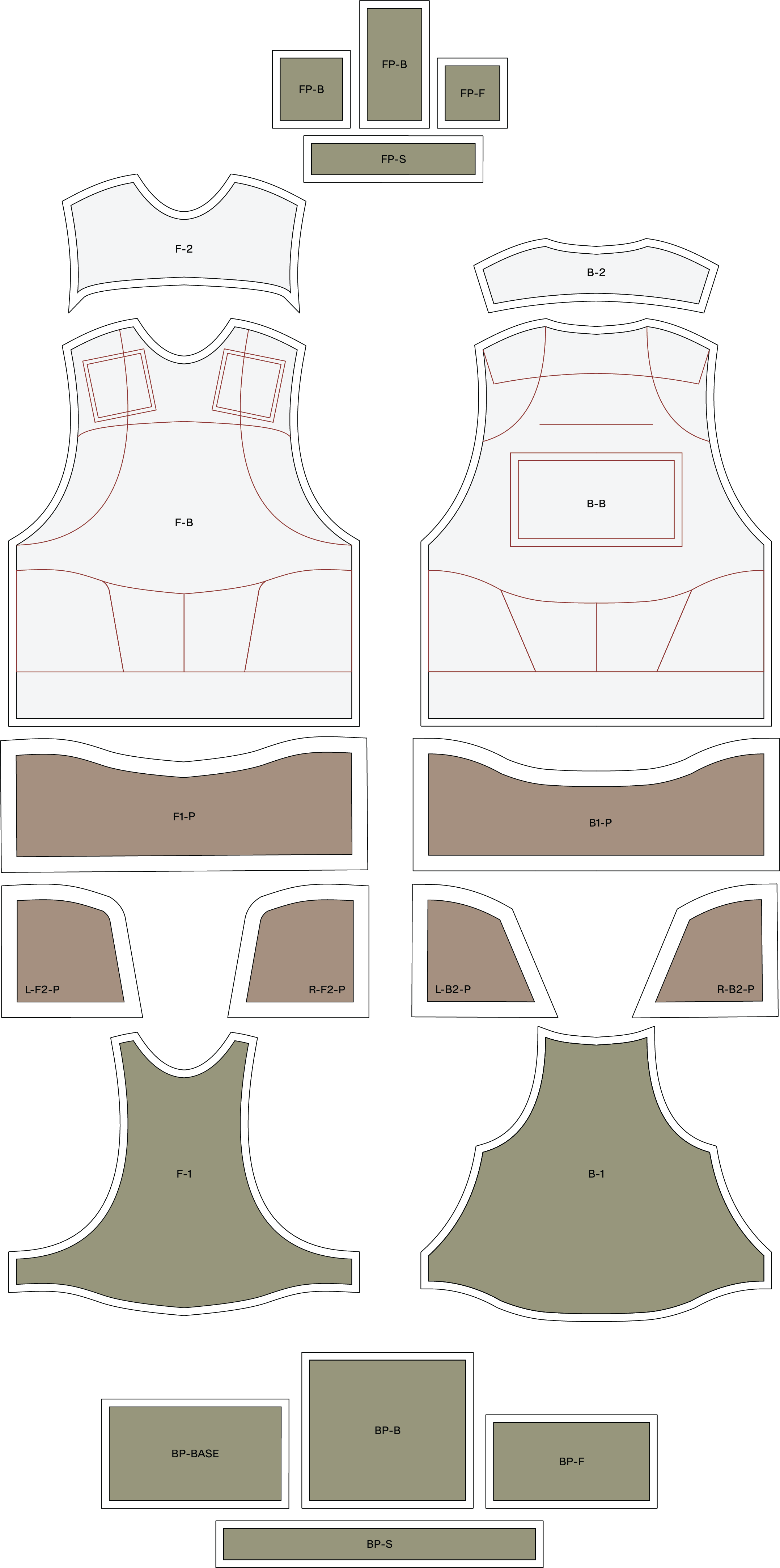
PANTS
Due to time constraints and other factors, I was unable to finish the pants, but completed the pattern and 3D modeling.






The contrast of hydrophobic material colors seeks to encourage the visual rhythm originating in the absorbent pads, breaking up the totality of any one tone, and again references the relationship of division versus harmony, suggesting the plausibility of differences coexisting.


The entire waistline is composed of the absorbent pad material. The sides of the waist display the checkered sudo-embossed pattern, indicating areas of frequent use. While the areas closer to the middle of the waist and back are made of the same absorbent material, the cross-stitching is absent, as these areas are rarely utilized on the same level as the hips.

The absorbent pads on the DRIP vest are integrated seamlessly into the wearer’s current habits of wiping their hands on the sides of their hips, adapting the environment to the wearer, instead of the inverse. The removable quality of the vest allows the wearer to take the garment off at will, transforming it into a more handheld textile and adding to the versatility of its uses.

DRIP Textiles:
A Project About Sweat
PHYSICAL PRODUCT — Agutter: Senior Studio – 2022

DRIP is a project that aims to reduce the social alienation people with palmar hyperhidrosis (excessive hand sweating) can feel. Major impacts expressed by people with hyperhidrosis include limitations in relationships, and impairments in emotional and mental health. Through streetwear aesthetics, DRIP stylizes sweat, portraying people’s differences as unique, rather than unnatural.
EXISTING MITIGATION
Solutions for hyperhidrosis include extensive measures (such as surgery and microwave therapy) of body altercation in order to fit a social standard. I began observing and documenting the use of everyday clothing to absorb sweat.
PRIMARY MODE OF ABSORPTION
WIPING HANDS ON HIPS

SECONDARY MODE OF ABSORPTION
WIPING HANDS ON PANTS

TEXTILE RESEARCH
Fabrics used in the most common clothing aren’t ideal for combating hyperhidrosis. Challenges include the wear and breakdown of common cotton (1), fading of dyes and dyes coloring hands (2), and low absorption capacity (3). Carrying a hand towel (4) to mitigate sweat may be unattractive or bring unwanted attention to a person’s hyperhidrosis.
1 (COTTON)
1 (COTTON)

2 (DENIM)

3 (POOR ABSORBENCY)

4 (TOWEL)

FUNCTIONAL PRECEDENTS
The composite material designed to efficiently absorb sweat was informed by embossing techniques used in paper towels, and layering methods used by mothers for cloth diapers.
COMPOSITE MATERIAL
 EXPLODED COMPOSITE
EXPLODED COMPOSITE

MATERIAL SELECTION
After sampling various fabrics, I utilized terry cotton as the base layer and a lightweight cotton-spandex blend as the top layer of the composite to create a high absorbency capacity, quick drying material.
SAMPLES






FINAL MATERIALS
TOP: COTTON/SPANDEX
BOTTOM: TERRY CLOTH


I sewed a grid into the pad to create a sudo-embossed effect and higher surface area variance, allowing the top fabric to more quickly absorb sweat and pass it on to the bottom layer.


AESTHETICS
After selecting fabrics and having a general idea of a clothing-related design intervention, I based the appearance of the design on 90’s hip-hop and rap streetwear, as well as contemporary urban style trends.

SKETCHING
Once the form and function had direction, I began sketching potential product interventions. I prioritized a vest-like form, to address the primary mode of sweat absorption, and additionally, pants to address the secondary mode.
VEST












PANTS



















STRUCTURAL MATERIALS
Although hyperhidrosis is typically an independent variable, heat can exacerbate the condition, so I opted for breathable, light materials for the majority of the garment, excluding the absorbent pads.
SPORT NYLON (BASE)
RIPSTOP NYLON (DETAILS)


FURTHER SKETCHING
Following the final selection of fabrics, I was able to solidify concepts for the form of the vest, while considering the structural behavior and interactions of all the fabrics with one another, and the possibilities for the clothing pieces.
![]()
![]()
![]()
![]()




MODELING AND PATTERN DRAFTING
Once the final form was realized, I began modeling the garment and pattern in CLO3D. Since I had no sewing experience, I then modified the pattern to be easily understandable without the use of typical sewing instructions.
VEST
![]()
PANTS
![]()
VEST

PANTS

PANTS
Due to time constraints and other factors, I was unable to finish the pants, but completed the pattern and 3D modeling.





FINAL PRODUCT

The entire waistline of the vest is composed of the absorbent pad material. The sides of the waist display the checkered sudo-embossed pattern, indicating areas of frequent use. While the areas closer to the middle of the waist and back are made of the same absorbent material, the cross-stitching is absent, as these areas are rarely utilized on the same level as the hips.


The absorbent pads on the DRIP vest are integrated seamlessly into the wearer’s current habits of wiping their hands on the sides of their hips, adapting the environment to the wearer, instead of the inverse. The removable quality of the vest allows the wearer to take the garment off at will, transforming it into a more handheld textile and adding to the versatility of its uses.


